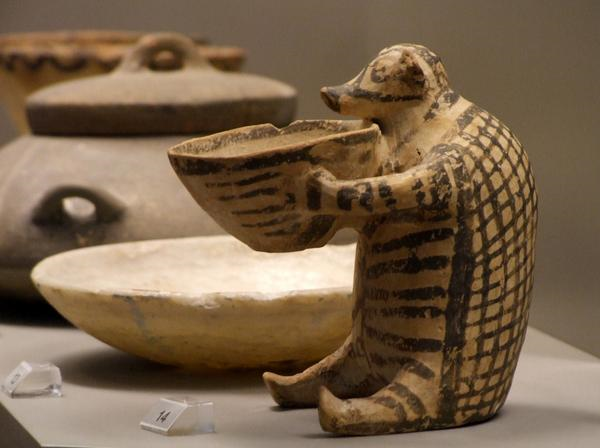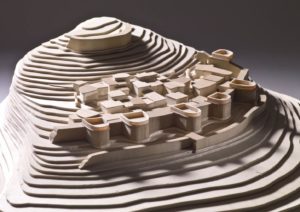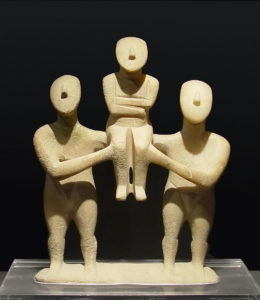The islands of the Cyclades, because of their position and their historical significance, mark the dawn of Greek culture. The particularly favourable conditions of the Aegean sea, the climate, the open horizons and the possibilities of communication between the islands gradually changed the mentality of the first settlers, who shifted from being shepherds and farmers to sailors and workers, merchants and artists. Ancient writers like Herodotus, Thucydides, Strabo and Kallimachos used the name ‘Cyclades’ to describe the islands which formed a circle around the holy island of Greek antiquity, Delos (Ortygia in Homer). According to tradition Carians, Lelegians and Phoenicians were the first inhabitants of the Cyclades. The oldest habitation in the Cyclades goes back to 9000 BC as is shown by the remnants of a Mesolithic settlement with ruins of houses and open-air tombs, which was discovered in the area of Maroulas on Kythnos.
The obsidian from Melos found in the cave of Fragthi at Ermioni in the eastern Peloponnese proves the organised presence of man in the Cyclades by 8000 BC.
The settlement found on Saliago, a small island between Paros and Antiparos, is a rare example of civilization on the islands during the last part of the Neolithic Age (4300 – 3900 BC) and it has produced valuable finds.
On Andros there is a settlement from 4000 BC on the plateau of Strofila. It is the biggest Neolithic settlement in the Aegean and has the oldest rock paintings in Greece.
From the end of the 4th millennium BC and during the 3rd, parallel to the Early Minoan Civilizations in Crete and the Early Greek civilisation on the mainland, a civilization with specific features flourished in Cyclades starting in Kea ( at the settlement of Kefala 3300 – 3200 BC ). It is known as the Cycladic civilization and it has left unique artistic artefacts to posterity, most distinguished of which are the Cycladic statuettes. This civilisation developed in small independent settlements based on the sea. The islands might not have land to grow plants on, but they were at the crossroads of the seaways between Asia Minor, Greece and Crete. Cycladic ships sailed the seas, making contact with the areas around the Aegean, and exchanging products and cultural ideas. The Cycladic civilisation, which covers the years of the Copper Age (3200 – 1100 BC) is divided into three periods:
- Early Cycladic period (3200 – 2000)
- Middle Cycladic period (2000 – 1650)
- Late Cycladic period (1650 – 1100)
A wooden model representing the castle-like settlement of Kastri on the island of Syros on a scale 1: 200. Very well-fortified settlements of this type built on top of the hills present typical examples of the Cycladic civilization at the end of its peak by 2300 BC (protocycladic II / III )
Source: Badisches Landesmuseum Karlsruhe / model construction: Bernhard Steinman 2011
During the first part of the Early Cycladic period houses were built on hills so that they were protected from floods and enemies. They were built far from each other without fortresses. The inhabitants were either fishermen or pirates. During the second part of this period Minoan Crete fought back against Cycladic pirate invasions. The people of the Cyclades lost control of the sea and were obliged to retreat into their heartlands where they built on hills protected by defensive walls. Houses were built very close to each other with narrow passages between them (Kastri and Halandriani on Syros, Agios Andreas on Sifnos, Panormos on Naxos, and Delos). During the 3rd period Cretan dominion is obvious. Almost all the settlements, except the ones on big islands with rich countryside, were again made by the seaside without walls around them (Melos, Paros, Amorgos, Thera). They were used as harbours for Cretan commerce. Cycladic houses were small (with one or two rooms) and without a fireplace. Their roofs were light, made of branches, reeds and flattened clay. The design of the houses was adapted to the available space. As a result they were sometimes in straight lines and sometimes in curved ones. Defensive walls were built around each group of houses. Cemeteries were located on nearby slopes.
The people of the Cyclades did not produce monumental art. Their artistic activities are mainly shown in the large number of small pieces of art found in their settlements and their cemeteries (funeral gifts): for example, pottery in the shape of frying pans, which are still being investigated as to their use (Halandriani on Syros island) and pottery in the shape of sauce-boats or animals, as well as marbleware. They excelled in metal art and miniature art (tools, silver brooches, diadems, necklaces). The finest creations of the Early Cycladic civilization are the wonderful marble statuettes which had continuous production during the 3rd millennium BC. Naïve and schematic at the beginning, they progressed steadily to exquisite imitative pieces of art with detailed features on the body or the face. Most of them represent females, sometimes in pregnancy, two dimensional and frontal. Later, when the artists were certain of the material they were working on and could make three-dimensional pieces, they constructed complex and amazing sculptures like the famous creations “The Harp-player” and the “ The Flute-player”, which were found on Keros and have become symbols of the Early Cycladic period.
During the next period of the Cycladic civilization, the Middle Cycladic period (2000-1650 BC), the Cyclades were still influenced by Minoan naval supremacy. This strong influence is quite obvious in Thera, where multi-storey houses were built and decorated with exquisite wall paintings (Akrotiri ). Settlements are still being built by the seaside ( Melos-Filakopi II, Paros-Parikia, Kea- Agia Eirini, Thira, Thirasia, Delos, Tenos, Syros, Sifnos, Amorgos), promoting commerce between Crete and the other parts of Greece. This period, having produced many valuable artistic creations, was interrupted violently by the destructive explosion of the volcano on Thera about 1650 BC.
During the Late Cycladic period (1650-1100 BC) we have the sudden disappearance of the Minoan civilization (at the end of the 16th century), most possibly as a side effect of the explosion of the volcano on Thira. As a result Mycenaean domination followed that of the Minoans. The first Mycenaean centres of trade appeared before the end of the 15th century.
By the beginning of the 14th century they had spread to Naxos, Delos, Kythnos, Serifos and Melos (Filakopi III). Three centuries later the decline of the Mycenaean world was felt in the Cyclades as well and soon after 1100 BC the last Mycenaean strongholds were abandoned .
The Cycladic civilization started being studied in the last decades of the 19th century mainly due to the archaeologist C.Tsountas, who excavated many Cycladic cemeteries in Syros, Paros, Antiparos and Sifnos.
Translation: Erene Drakou / Edited by Rupert Smith



